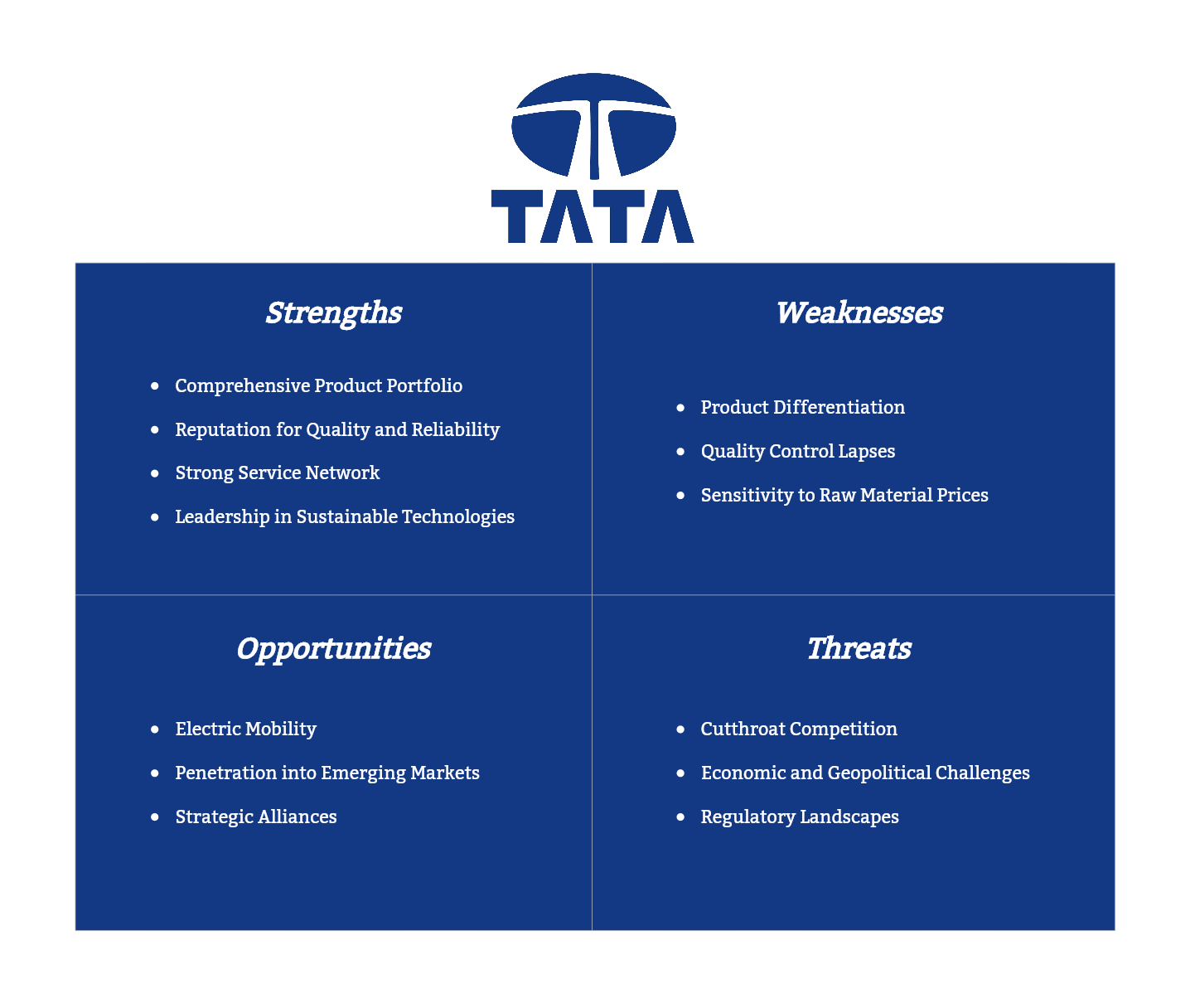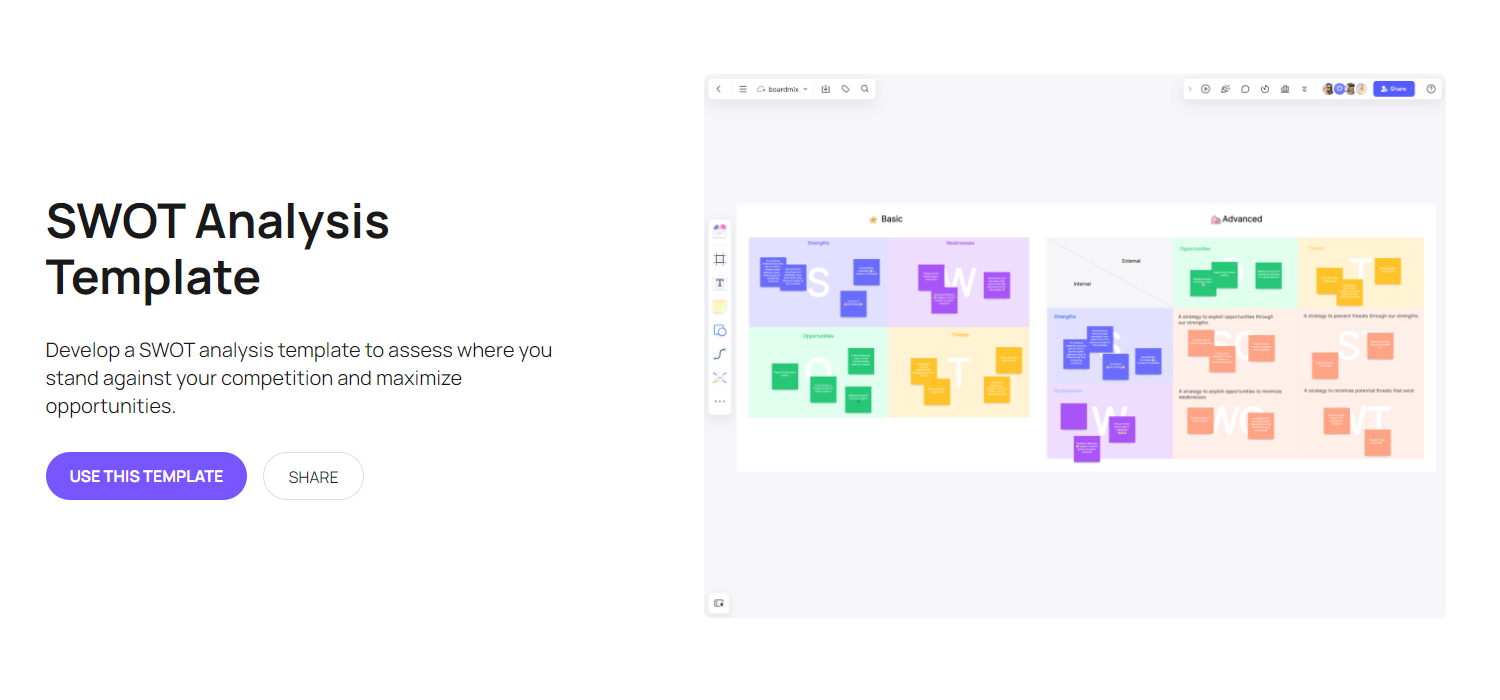The SWOT analysis is a powerful strategic planning tool businesses use to evaluate their internal strengths and weaknesses and external opportunities and threats. In this article, we will delve into Tata swot analysis, a prominent player in the automotive industry, to gain a deeper understanding of its position in the market. Keep reading.

What Is the SWOT Analysis
The SWOT analysis is like the main ladder for businesses. It stands for Strengths, Weaknesses, Opportunities, and Threats. Imagine it as a roadmap that helps companies understand what they're good at, where they need to improve, what new avenues they can explore, and what challenges they might face. It's a powerful tool that guides strategic decision-making and keeps businesses on the right track. So, let's embark on this journey to unravel the SWOT analysis and see how it shapes the success of Tata Motors.

An Overview of Tata Motors
Tata Motors, a proud member of the revered Tata Group, has been driving innovation since its inception in 1945. With a global footprint spanning over 175 countries, Tata Motors has emerged as a powerhouse in the automotive domain. From passenger cars to commercial vehicles and defense machinery, their diverse portfolio showcases a commitment to excellence and sustainability.
What sets Tata Motors apart is not just their cutting-edge technology, but their unwavering dedication to quality and customer satisfaction. They don't just sell vehicles; they deliver trust, reliability, and a promise of a better, sustainable future. This customer-centric approach combined with a keen eye on industry trends makes Tata Motors a true leader in the automotive landscape.

SWOT Analysis of Tata Motors
The detailed SWOT analysis of Tata Motors is below. So:

Strengths of Tata Motors
- Comprehensive Product Portfolio: Tata Motors isn't confined to just one segment of the automobile industry. From passenger cars like the Tata Nexon to buses, trucks, and even defense vehicles, their range covers a spectrum of consumer and industrial needs. This versatility ensures they have a presence in multiple market segments, catering to varied consumer demographics.
- Reputation for Quality and Reliability: Through years of experience and feedback, Tata Motors has honed its manufacturing processes and quality control, resulting in vehicles that are dependable. When consumers buy a Tata vehicle, there's a sense of trust that it will serve them well for years.
- Strong Service Network: After-sales service can be a significant differentiator in the automobile industry. Tata Motors has worked on creating an extensive network of service centers, ensuring that vehicle owners can get timely and quality maintenance and repairs, enhancing the overall ownership experience.
- Leadership in Sustainable Technologies: In a world moving rapidly towards sustainable solutions, Tata Motors has been a pioneer, especially in India, with their electric vehicle offerings. By investing in EV technology, they are setting themselves up to be market leaders in an inevitable green future.
Weaknesses of Tata Motors
- Product Differentiation: With many players in the automobile sector offering similar features and value propositions, it's crucial to stand out. Tata Motors, in certain segments or markets, might face challenges in distinguishing their products from competitors, affecting consumer choice.
- Quality Control Lapses: While they have built a reputation for reliability, occasional lapses or recalls can cast a shadow on their brand image. In the age of social media, such incidents can be amplified, necessitating swift corrective action.
- Sensitivity to Raw Material Prices: Like all manufacturers, Tata Motors is at the mercy of global commodity markets. Fluctuations in the prices of steel, rubber, or other materials can squeeze margins, forcing them to adjust their pricing strategy, which can have downstream impacts on consumer perception and demand.
Opportunities of Tata Motors
- Electric Mobility: As global sentiment shifts against fossil fuels, electric vehicles are the future. Tata Motors has an opportunity to be at the forefront of this revolution, especially in markets where EV infrastructure is in its nascent stages.
- Penetration into Emerging Markets: Countries in Asia and Africa, with their burgeoning middle classes, are ripe for automotive growth. By tailoring products to local needs and establishing a strong on-ground presence, Tata Motors can capture significant market share in these regions.
- Strategic Alliances: Partnerships can be transformative. By aligning with tech firms for software solutions, battery manufacturers for enhanced EV range, or even other automotive players for shared platforms, Tata Motors can leapfrog developmental stages and access new markets or technologies.
Threats of Tata Motors
- Cutthroat Competition: The automotive sector is fiercely competitive. Established global giants, emerging local players, and even tech firms are vying for a piece of the pie. This competition can lead to aggressive pricing strategies, impacting profit margins.
- Economic and Geopolitical Challenges: The automotive industry is sensitive to macroeconomic factors. A recession, trade wars, or geopolitical unrest can disrupt supply chains, skew demand, and even force re-evaluation of entire market strategies.
- Regulatory Landscapes: Emission norms, safety standards, and even consumer protection laws can vary widely from country to country. Staying compliant while ensuring profitability is a juggling act that Tata Motors, like all automakers, needs to master.
SWOT Analysis Template & Tool
Introducing you to the simplest tool Boardmix. This is an intuitive platform designed to streamline strategic decision-making. With its user-friendly interface and customizable features, Boardmix empowers businesses to conduct SWOT analysis effortlessly.

The SWOT analysis template provided by Boardmix comprises four quadrants, facilitating a comprehensive evaluation of Strengths, Weaknesses, Opportunities, and Threats. This invaluable tool equips businesses with the insights needed to make informed decisions and formulate effective strategies, ensuring a competitive edge in the dynamic business landscape.

Conclusion
In the journey through SWOT analysis of tata motors, it's evident that this automotive titan stands on a solid foundation of strengths, from its diverse product portfolio to its pioneering efforts in sustainable technology. While facing challenges like differentiation and occasional quality control lapses, Tata Motors has the potential to seize opportunities in the electric vehicle revolution and emerging markets. With tools like Boardmix's SWOT analysis template, businesses can embark on a similar journey of strategic planning, ensuring a clear path to success in today's competitive landscape.








